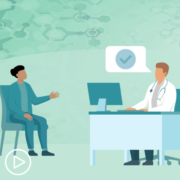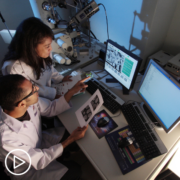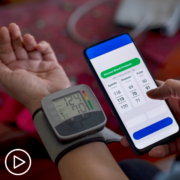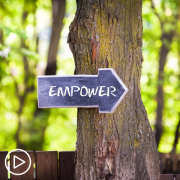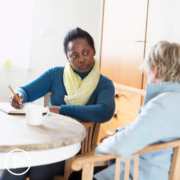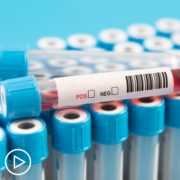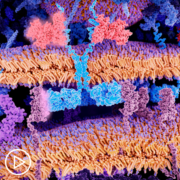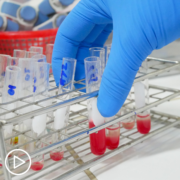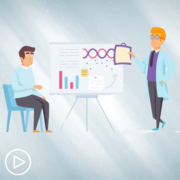Accessing Personalized Myeloma Treatment | What Patients Should Know from Patient Empowerment Network on Vimeo.
Myeloma experts Dr. Francesca Cottini and Dr. Ashley Rosko provide an overview of the latest advances in essential testing for myeloma and explain how results could affect care and treatment decisions. Drs. Cottini and Rosko also review available myeloma therapies and their hopes for the future of patient care.
Dr. Francesca Cottini is Assistant Professor in the Division of Hematology at the Ohio State University Comprehensive Cancer Center. Learn more about Dr. Cottini.
Dr. Ashley Rosko is Medical Director of the Oncogeriatric Program at the Ohio State University Comprehensive Cancer Center – The James. Learn more about Dr. Rosko.
Download Resource Guide
See More From INSIST! Myeloma
Related Programs:
Transcript:
Katherine:
Hello and welcome. I’m Katherine Banwell, your host for today’s program. Today we’re going to discuss how to access personalized care for your myeloma and why it’s vital to insist on essential testing. Before we get into the discussion, please remember that this program is not a substitute for seeking medical advice. Please refer to your healthcare team about what might be best for you. Let’s meet our guests for today. I’ll start with Dr. Ashley Rosko. Dr. Rosko, welcome. Would you please introduce yourself?
Dr. Rosko:
Hi everyone. My name is Ashley Rosko. I’m an associate professor at the division of hematology at The Ohio State University.
I’m also the medical director of the oncogeriatric program here at The James and one of the myeloma physicians here at Ohio State.
Katherine:
Thank you. Also with us is Dr. Francesca Cottini. Dr. Cottini, would you please introduce yourself to the audience?
Dr. Cottini:
Sure. My name is Francesca Cottini. I am an assistant professor in the divisions of hematology at The Ohio State University. I see patients with multiple myeloma, and I also run my own lab where I focus on multiple myeloma basic research.
Katherine:
Thank you both for taking the time out of your busy schedules to join us today.
It’s no secret that it’s important for patients to take an active role in their care and treatment decisions, and I’m sure many viewers here today are doing just that. So, Dr. Rosko, let’s start with this question: Why do you think it’s essential that patients advocate for themselves and insist on better care?
Dr. Rosko:
Yeah, so I think when it comes to uncommon diseases like multiple myeloma –
Although we’re talking a lot about it here today, myeloma is an uncommon cancer, and when it comes to rare cancers, it’s really important for you to get care at either a comprehensive cancer center or a place where there is expertise specifically in multiple myeloma.
And the reason why that’s so important, it’s recommended through the NCCN guidelines and other standing guidelines is because myeloma is a very – it’s a shifting and changing landscape when it comes to both treatment regimens, diagnosis, and there’s a lot of moving parts and pieces.
Such as, there is an uncommon cancer that when diagnosed, we do recommend that patients and with their caregivers and with their families and support be able to seek expertise care for these uncommon cancers. We work often in collaboration with our community team, but we would not be able to care for myeloma if it were not for our community partners.
And so, it’s really, really important for patients oftentimes, when there’s been such a diagnosis, they can come to a comprehensive cancer center for a consultation or to be able to get a second opinion oftentimes. And then continue to get care locally. It really provides this overall guidance on the management and diagnosis of uncommon plasma cell disorders, and we’re happy to do that.
Katherine:
Thank you for that. It’s helpful as we begin our discussion. Part of accessing more personalized care starts with test results. Dr. Cottini, what testing should take place following a myeloma diagnosis?
Dr. Cottini:
So, once somebody is diagnosed with multiple myeloma, there are different types of tests that we need to get. Some are blood tests, some are urine tests, some are bone marrow tests, and others are just different types of imaging. So, the reason for all these tests is because multiple myeloma can kind of go everywhere and can cause the damage to different types of organs.
So, if we look at blood tests, usually you would see that you get the complete blood count, so we can count the number of red blood cells, white blood cells, and platelets. And then we’ll look at kidney function, through a chemistry profile, calcium levels, multiple myeloma can affect bone cells can affect kidneys. And then, you will see some more sophisticated tests that are really important for the diagnosis of multiple myeloma but also for monitoring and seeing if you’re actually responding to the treatment or you are progressing.
These two tests that you can see are kind of difficult to say, but very important and needs to be remembered. So, one is called serum protein electrophoresis with immunofixation. And the other one is free light chain assays.
And the practicum with these two tests is we can identify the specific marker of the multiple myeloma cells and it is either something monoclonal protein or M-protein or kappa light chain numbers. And as I said before, these numbers can be monitored. So, in response to the treatment, they should go down. And then, unfortunately, if we see progression, they might go up again.
And then, urine tests can also give the same type of numbers. Usually, we have our patient keep the urine for 24 hours, for a day, and we can see if there’s monoclonal proteins or light chains there, too. Then there is a least favorite test of all of them that is the bone marrow testing. So, this is very important for us, because it’s where most of the myeloma cells stay. So, we need to have a look at the bone marrow.
We need like a piece of the bone and some of the liquid tissue to look at specific characteristics of the myeloma. And then, I said before, the myeloma can go to bones, so we need to kind of get some imaging of the bones. These are usually a set of X-rays – it’s called skeletal survey – to see if there is any area that is abnormal or at risk of fractures.
Then, we are also looking at PET scan, which is a more sophisticated test that is based on sugar consumption. We know that myeloma cells and all cancers enjoy sugar, so with the PET scan, we can see visually where the myeloma cells are in the body.
Katherine:
What is cytogenetics?
Dr. Cottini:
So, this is a really interesting question. So, cytogenetics, or FISH tests, are tests that practical tests allow us to look at the chromosomes of the multiple myeloma.
So, everybody has 46 chromosomes, right? Multiple myeloma cells can have more of them or less of them. So, they can have – some myeloma cells have 17 chromosomes instead of 46. So, cytogenetics in the karyotype counts how many chromosomes there are. And then, there is another type of test that is called FISH test, or fluorescence in situ hybridization – I get all the difficult names – that practically look at specific area of chromosome. It can tell us if some areas of chromosomes are lost. That’s what you can read as deletions, or practically missing pieces of chromosomes.
Or there are extra pieces of chromosomes. These are the amplification gains. Or if there are different pieces of chromosomes that stick together. And these are the translocational chromosomes. And all of these data are important for deciding for knowing how aggressive or difficult to treat the myeloma.
Katherine:
Dr. Rosko, in many other cancers, we’ve been hearing about targeted therapies and immunotherapies. In some cases, a specific mutation or chromosomal abnormality may indicate that a particular treatment may be effective. Are we there yet in multiple myeloma care?
Dr. Rosko:
Yeah, so, myeloma care is always a little bit different. So, myeloma, being a blood cancer, is different than other solid tumors and how we treat it is also a bit different. So, unlike solid tumors, in which we look at the size of a cancer and then if it’s in different places in the body. In multiple myeloma, it being a blood cancer, just by definition it’s throughout the body. So, we have to be able to estimate or stage cancers differently or stage myeloma differently. And it is based upon the cytogenetics that Dr. Cottini just outlined to you.
So, to get back to your question, Katherine, I didn’t forget about, how do we define treatment, how are some of these therapies being defined specifically and personalized for persons with multiple myeloma? And we do do that. And it is based a lot upon the DNA of those cancer cells and whether or not they’ve acquired what I would call a standard-risk changes or whether or not they’ve acquired a biology that makes them tend to act more aggressively. Now, again, these DNA differences – not all cancers follow the book, and not all therapies are unique to these.
But what it does help us to do as clinicians to say, “Well, we have standard risk mutations within these cancer cells, and then we can define oftentimes how many drugs a patient gets when they’re newly diagnosed. Just like many other cancers, our treatments for multiple myeloma can be a combination of pills or shots. And then, if patients carry mutations that tend to act more aggressively, we tend to be very aggressive with their upfront therapy. For many patients, we’d receive three medications. Patients with more aggressive disease biology may receive four medications.
And it’s very unique upon many characteristics. It’s not only based upon the cancer cells’ DNA but also the health of the patient. The health of the patient really defines also the ability to tolerate treatment. So, many patients are – myeloma has a lot of heterogeneity to it, where some patients with myeloma can’t believe that they could possibly have this cancer.
You know, it’s really kind of picked up subtly, with blood abnormalities. And then some patients with myeloma come into the hospital very very sick, with having kidney damage or having infection. And it runs the gambit between being asymptomatic really and having patients coming in quite unwell. That also influences our treatment decisions. So, when we think about the question about whether we have different immunotherapies or targeted therapies based upon the genetic changes within the myeloma cancer cells, the answer is yes, we do shape therapy that’s tailored around the type of abnormalities within the cancer cells.
But unlike some cancers, where if the cancer cells carry a specific marker, we give a specific drug, that’s not quite where we’re at with multiple myeloma, in terms that providing therapy is saying, “If you carry this mutation, this is what you should get.”
So, it’s a very long answer to say to you that we do personalize therapy based upon changes within the DNA, but we also base it upon how fit the patient is and how their health was prior to developing cancer.
Katherine:
Thank you for that. Dr. Cottini, what mutations or abnormalities are you looking for?
Dr. Cottini:
So, as Dr. Rosko said, and as I quickly previously mentioned, so there are different types of DNA tests that we can do. One is this FISH test, and that’s a standard test. It’s usually done practically everywhere. And it practically tells us if there are specific deletions or changes.
And we don’t really have yet a specific medication that we know works for specific abnormalities. But all this information is important to decide, as Dr. Rosko said, number of drugs, and maybe that can be helpful in the future when hopefully thanks to the research, we will be able to say, “Based on this abnormality, you would benefit more from this type of treatment.”
There are other types of tests. One is called DNA testing, so we look at the mutation. So, really to point to small changes of a particular gene. This is done not routinely, but I think it can still give lots of good information. And there are lots of genes that are normally myeloma, that has potential drugs that have been studied, those with multiple myeloma and any other type of cancer.
Katherine:
Yeah. Dr. Rosko, what do the results of these tests tell you about prognosis?
Dr. Rosko:
Yeah, I think this is a really important question. And, in my experience, when we encounter a patient newly diagnosed with myeloma, it is like drinking from a firehose in terms of the amount of information that we are reviewing and the amount of information that we are discussing with the patient and with their family. And oftentimes, we talk about this piece of these cytogenetic abnormalities, and we talk about – but I really encourage your patients and anyone who is listening in today to really take a deeper dive.
Because sometimes it’s helpful as, one, you’re navigating a new cancer diagnosis, but that’s challenging in and of itself. And then, two, talking about a cancer, multiple myeloma, that is – most people don’t know so much about multiple myeloma, unlike breast or colon or lung cancer, and so I really encourage patients and their caregivers. And a lot of times this happens, where we’ll go over all the cytogenetic abnormalities, we’ll talk about how it plays a role in their overall treatment trajectory, and their prognosis, but also good just to circle back and say.
Settling into what this diagnosis is, oftentimes, people on first time treatment. And then even sometimes months or even years into their diagnosis, they stop and they come back and they say, “Can we talk about this FISH data? Can we talk about what changes that I had within the DNA? What does this mean?” And that’s not uncommon at all.
So, I really feel like for many people that are on the call here today, I think it’s important to say it’s okay to go back to your physician and say, “I’m learning more about this, now that I’m more familiar with what this diagnosis is, can we talk about these FISH changes, or can we talk about the stage of my cancer?” Because I think it’s oftentimes an overwhelming period of time to have a new cancer diagnosis. And I also want to just give permission to everyone on the call that it’s okay to go back and ask questions, even if it’s been months or years.
So, having high-risk mutation can upstage a cancer and in the absence of high-risk mutations can downstage a cancer. So, what that really means is saying, “These biologic changes that are happening in the cancer cells give a sense of what we anticipate that the trajectory is going to be when someone is diagnosed.”
Now, it’s imperfect. I feel like cancer just generally is unpredictable and there are many things that we try as clinicians. And especially with the experience that we have, to say, “This is what we anticipate the course will be like you, in terms of response, in terms of the cancer being quiet.” As you all know, multiple myeloma is not a curable cancer right now. And for all patients, when they’re diagnosed, they’re often able to get disease control and be able for that cancer to be put in remission. And we do focus on remission.
I think that’s also something that I talk to my patients about. Even though we can’t cure it, we can certainly control it, and that’s a big part of what we do. So, when we get good disease control, we’ll talk more about next therapies, but that is how Dr. Cottini – Dr. Cottini is a wonderful scientific investigator and knows all of the latest and greatest when it comes to different mutations that are identified within cancer cells. We partner very closely with her in terms of scientific investigation and how the mutations that were newly identified, too, play a role in terms of response to treatment, and how we’re able to best treat them.
Katherine:
Thank you for that. Dr. Cottini, do you have anything to add as far as what type of questions patients should ask their healthcare team about test results?
Dr. Cottini:
I mean, I think Dr. Rosko already pointed out the most important things. So, multiple myeloma is a rare disease, and it’s not as intuitive to understand as breast cancer, lung cancer, prostate cancer.
So, it’s really important as a patient to understand which tests are we ordering. Why are we ordering? How do we monitor the disease? Because that’s one of the most important questions the patient asks, because for different types of solid tumor, we get imaging, and we know that the tumor is growing or not. Where, for us, we look at the markers I had described previously. And sometimes, we maybe see small changes in the markers that are very concerning and worrisome for the patient, but sometimes they are not. So, I think asking questions about the testing and how we treat them and monitor the disease is a very important part of being a good applique for itself.
Katherine:
Thank you. Dr. Rosko, I’d like to move on to treatment. We know that multiple myeloma patients have a number of options and that many available therapies are used in combination.
So, I’d like you to walk us through the options that are available.
Dr. Rosko:
So, I’m going to start by how the best way that I can frame out when we talk about newly diagnosed versus patients when they have relapse. So, there are therapies that are available for patients that are FDA-approved when they are newly diagnosed with the cancer, and there are therapies that are approved only when a cancer has acted up again or relapsed.
So, I’ll kind of frame it from patients who are newly diagnosed. And then, I also will talk more about relapsed therapies and what we’re able to offer to patients. So, in first, when we talk about treatment options, we frame treatment based on a couple things. So, one is, we talk extensively about the disease biology. So, that plays an important role in how we decide which treatment the patient should get.
And then, the second part about how – I would probably say there’s about four main parts. And so, disease biology is one, and another thing has to do with the patient characteristics. In terms of the patient’s overall health prior to developing cancer, and also how the cancer has impacted their health in terms of everyday activities. Whether or not a person has really slowed down quickly, whether they’ve been in the hospital, and how it’s impacting their organs. Because that plays a role in terms of what we’re able to give patients.
If a patient has advanced kidney failure, which can sometimes happen, or if you have to focus more on protecting their bones and if there’s concern about fractures and things like that. And then independent of patient characteristics in terms of overall health, the last part I talk to patients about is their own preferences. It’s a hard thing to talk about, shared decision-making in a cancer that most people have never heard about, but there is certainly – when we talk about options and there are, it’s important to talk about shared decision-making in terms of what’s most important to them and where they – and most patients will say, “Well, I just want the best medicine.”
And I say to them, “Well, you know, we have lots of options, and that’s the best thing about it, but we also want to be cognizant of the real world, of giving best options,” and for example, Many of my patients – so, I’m at The Ohio State University, I’m here. And a lot of patients travel. I have a lot of older patients that I care for, and they’re very independent with travel. And I want to make sure that whatever therapies we’re getting for them, that we can do this in such a way that maintains their lifestyle.
So, the beginning part of a treatment, it is broadly described as – when we talk about someone who was diagnosed with this, it’s this thing called induction. So, induction is when we give anywhere from two to four medications to be able to control their cancer and put it into remission. And we know that the cancer is in remission because, like we started out the conversation with Dr. Cottini, myeloma makes proteins. Oftentimes, it makes proteins, those proteins are not nutrition proteins but are cancer proteins that we can track in the blood.
So, we can check them every month and to make sure that the patients are having a really good response, and as such, we’re able to define that they’re responding to their treatment. Because they have a beginning stage in induction, which they’re given treatment, and then the goal is to put patients put in remission.
Depending on the overall health of the patient, a standard of care for most patients diagnosed with multiple myeloma is to undergo an autologous stem cell transplant. An autologous stem cell transplant is not a transplant in which you’re getting cells from your brother or sister and they’re being donated to you. They are your own stem cells. We get them out of you when your bone marrow is free of disease, and then we would admit you to the hospital for a more intensive therapy and give them back.
That is often the standard of care for patients newly diagnosed with multiple myeloma and it is recommended for most patients. Some patients get – I like to think of it as a stem cell transplant not at the time of their initial diagnosis, but later on at the time of relapse or some patients are not candidates for a transplant or elect not to have a transplant. And all of these options are very personalized to the patient. It’s very hard to say that this is exactly what we do.
Because it’s a strategy where it requires a lot of shared decision-making to make sure that we’re getting good disease control, good quality of life, and deep, deep remissions for our patients. So, then, if a patient gets a transplant, there’s a period of recovery, and then patients go on a pill most often, a maintenance pill that they stay on for indefinitely.
Myeloma is also a cancer which has perpetual therapy. Very different than many other cancers, where there’s a beginning and an end, myeloma for the most part is perpetual therapy, where you get some form of therapy at higher dosages versus lower dosages over a period of time.
So, I’m going to talk broadly about the classes of drugs that we have and how we use them to be able to define therapy.
So, the first class of drugs are called proteasome inhibitors. Just like many other cancers, we use different types of drugs to be able to target different aspects of a cancer cell’s growth cycle.
So, very similar to how we do other drugs, these are very specific to the cancer cell, and they’re very targeted. So, unlike some of our other kind of classic chemotherapies, many of these medicines that I’m going to talk about are very targeted at the cancer cells without causing too many other problems.
So, proteasome inhibitors include drugs like bortezomib (Velcade), which is given as a shot, carfilzomib (Kyprolis), which is given as an IV, or ixazomib (Ninlaro), which is given as a pill. They have different indications, but they’re the same class of drugs.
The next class of drugs is called immunomodulatory drugs, or iMiDs. This includes things like lenalidomide (Revlimid), pomalidomide (Pomalyst). Those are the most common, and then we sometimes use the drug that the original iMiD drug, which is called thalidomide (Contergan).
These are all pills that patients take, and so that’s oftentimes very nice for patients to be able to provide therapy at home, very well-tolerated. The next class of drugs are called monoclonal antibodies. On a cancerous cell, there is a marker.
And so, we use monoclonal antibodies to be able to target the marker on the cancer cell. What that means is very specific. To that cancer cell, so, the most common target is the CD38, that’s a marker on one of the cancer cells. And we use a drug called daratumumab (Darzalex), that can be given as an IV or a subcutaneous agent, or another drug called isatuximab (Sarclisa). We also have other markers on the plasma cell. There’s a marker called SLAMF7, which we have other drugs called elotuzumab (Empliciti), which is often used for patients more in the relapse setting.
Katherine:
Dr. Cottini, I’m wondering if you could briefly go over CAR T-cell therapy and bispecific antibodies.
Dr. Cottini:
Yes, of course. So, these are all our new therapeutic approaches for patients. And these are types of treatments that are given to patients that already went through their induction, they went into remission, maybe they had a bone marrow transplant. And then, after a couple of years or months, unfortunately the disease came back, and they need the new and different treatment options. So, these two strategies, CAR T and bispecific antibodies, really rely on the T-cells, on the immune cells of the patient.
And they all focus and target a specific marker on the plasma cells, but they work a little bit differently. So, the bispecific antibodies – and we have different antibodies.
Some are approved by the FDA, some are just in clinical trials trials. They practically recognize something that is on the plasma cells, on the myeloma cells, that can be BCMA, GPRC5D, or other targets. So, at the same time that I am able to get close by the T cells, the immune cells, and in this way, practically there is both the antibodies and also the immune cells which is activating and getting rid of the cancer cells.
So, these are infusions. Often, they’re done initially in the hospital and then in the outpatient setting. Sometimes it’s even every week, every other week or so.
CAR T are different strategies, and it’s a very smart way of trying to get rid of the cancer cells. So, practically, these are T cells.
So, these are immune cells from you, from the patient. And they are practically taken and then brought to a very specific and clean facilities where these T cells are modified in order to be able to recognize the cancer cells.
And then these cancer cells are sent back to us and then practically they are given into the veins to patient, and then there is this kind of reaction of these T cells, which are very peppy and aggressive to be able to kill all the remaining cancer cells. So, these are all the new strategies.
Obviously, we are kind of like in the early process, but these are very promising therapies I think we’ll be maybe moved up front even with diagnosis in the next 10, 20 years, we don’t know.
Katherine:
I want to thank you both so much for your thoughtful responses. And as we close out the program, I’d like to get a final comment from each of you. What are you excited about in myeloma research, and why should patients be hopeful? Dr. Cottini?
Dr. Cottini:
So, I think that especially if we look back especially at where myeloma was 20 or 30 years, I think we have made so many progresses, and there is really hope for our patients. I’m very passionate about research. That’s what I do. That’s why I read paper, I publish paper, and I think that it’s the heterogeneity of our disease is huge, and it’s difficult to tackle. But we as researchers, as physicians are the ones that can look at these changes, and find new therapies for our patients. So, I think that research is the way to go to be able to finally cure our patients.
Katherine:
Dr. Rosko?
Dr. Rosko:
Yeah, I mean I go Dr. Cottini’s sentiments. The multiplying therapies for myeloma really provides our ability to prescribe and make myeloma more of a chronic illness for our patients. I think it’s really important to allow patients to get really good targeted therapy personalized to them. Of course, we all are looking forward here to deep remissions. We want to be able to do that in such a way where we have good quality life for our patients.
I think, importantly, as part of this program does here, we have to create access. So, most of myeloma is treated in the community, and most myeloma is diagnosed in older adults. And I really think how important it is, we talk about clinical trials, and being able to get our patients on to clinical trials, and to be able to get more knowledge about the disease process of pathogenesis, which I think is just really pivotal.
So, I’m excited about personalizing therapy to the individual’s health and really being able to increase access to all of these novel therapies that we have. For patients, often at specialized cancer centers, but I’m really interested in how we can increase reach and access for all of these advances in myeloma research to every patient no matter where they’re at.
Katherine:
Well, thank you both for joining us today. And thank you to all of our partners. To learn more about myeloma and to access tools to help you become a proactive patient, visit powerfulpatients.org. I’m Katherine Banwell. Thanks for being with us.
